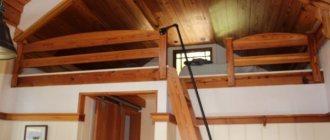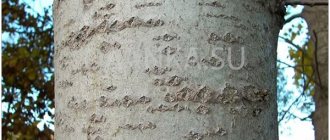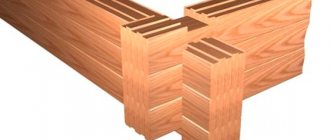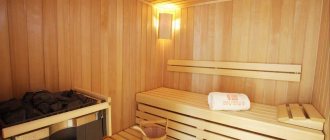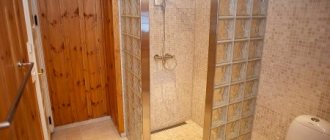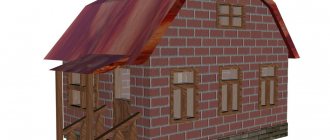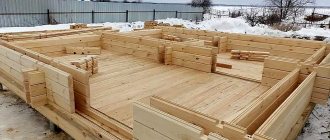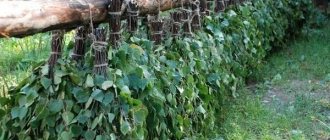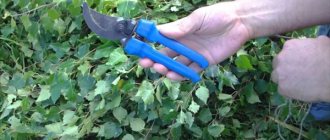A finished log house requires timely insulation, so it is especially important to choose a high-quality and environmentally friendly material that will provide the building with proper air exchange.
There are two categories of insulation on the construction market - synthetic and natural.
Synthetic-based insulation materials are not particularly practical and safe to use, so they are not the best option for wooden buildings.
The right choice is construction moss for a log house. Natural insulation with high performance characteristics.
Moss selection
Two varieties of mosses grow in Belarus, differing in appearance and performance characteristics: sphagnum and cuckoo flax.
Sphagnum
Sphagnum, or white moss as it is also called, is found in coniferous forests and wetlands. The plant has a long pile - green at the top and whitish at the bottom. The roots are short and unbranched (after they die they turn into peat), so collecting the tops is not difficult.
White moss is hygroscopic and not very durable. To insulate a log house, the material must be purchased with a reserve, since when it dries it greatly decreases in volume. With prolonged use, sphagnum caulk crumbles.
Kukushkin flax
It grows in the lower reaches, on forest edges, and in swamps. The plant received its name for its external resemblance to flax: it has tall reddish stems with bright inflorescences. Unlike white moss, red moss is more reliable and durable as insulation for wooden structures. It is dense, elastic, and absorbs little moisture.
Moss for logs
Hello dear homemade people.
On this page, I will try to tell you everything I know about what kind of moss is best for laying a frame, and how to collect this moss, transport it, lay it, and then punch it.
I was inspired to include the topic of moss in a separate post, I was inspired by many years of observations of the condition of various cushioning materials and various types of moss used when installing log houses.
Quite often I had to not only install new log houses, but also dismantle the old ones in order to free up the site.
In general, disassembling and reworking gives very good knowledge in the sense that when disassembling something, you can immediately see what was done wrong, and what material did not behave as expected.
Same with the log house. Taking it apart, you can immediately see what is visually inaccessible when assembled. Namely, what happened in the space between the logs during the time during which this log house was a home
Dismantling provides useful knowledge.
Advantages
Let's start by identifying several undoubted advantages of moss over flax. Firstly, moss is not afraid of moisture, since it does not absorb it. It uses moisture only for growth.
Secondly, moss prevents wood from rotting. Even on the lower crowns of the log houses, which are more exposed to rain than others, I did not see any traces of rotting in the grooves. Apparently moss also has antibacterial properties.
Thirdly, moss is much easier to work with than tow.
There will also be fourth and fifth ones, but more on that below.
Which moss is better
Let me make a reservation right away: I will only talk about the mosses of the European part of Russia, since I simply don’t know what grows in Siberia, or in the north and south.
But even about our mosses, there are a wide variety of opinions, even in Mari villages.
I will tell you what I saw with my own eyes, touched with my own hands, and what conclusions I came up with as a result.
Moss grows almost everywhere in the forest. It is found in wetlands and on hillocks, in deciduous forests and in coniferous forests, and everywhere you can find several of its species.
Let's start with bog moss. It is also scientifically called Sphagnum, but I am not a botanist, and the site is not about the flora of my native land, so we will not focus on this, we will just be aware.
Swamp moss is usually very long, not littered, and has a light green, almost white color at the bottom. It is easy to assemble and easy to stow.
But it has one undoubted drawback. It contains a large amount of moisture, and when it dries, it becomes quite loose and loses a lot in volume.
As a result, you have to put more of it. And then it also takes a lot more to punch through. But punching is a very tedious task, and it is better to reduce it in all possible ways that do not affect the quality, of course.
By the way, at first I was very surprised when I learned that moss punching in villages is done by women. And then I realized, when I tried this work, that the guy just didn’t have the patience to do it very well.
Women, when it comes to meticulousness, monotony, and meticulousness, turn out to be much better workers than men.
In fact, before use, it is recommended to dry the swamp moss, so as not to overdry it. The criteria for high-quality drying are purely visual and tangible.
In short, it should be dry, but curl into a rope without breaking. You need to dry it in a thin layer so that it dries evenly. Imagine: scattering a hundred bags in a thin layer. Gimp.
Despite these disadvantages, swamp moss is still a good cushioning material. The grooves of the logs that were filled with it have a fairly fresh appearance, although the log itself turned black a long time ago, and the blackness penetrated to a depth of more than a centimeter.
Red moss is found in the lowlands. I really haven’t seen any examples of its use, but several times I have heard disparaging reviews: “Ah, this is cuckoo flax.”
It is quite tall, and has relatively thick stems, and again relatively large inflorescences. Apparently, therefore, it will be difficult to make a gasket made of such moss dense enough.
Well, since I didn’t encounter cuckoo flax when dismantling log houses, and didn’t work with it, I can’t tell you about it in more detail.
But I would like to tell you in more detail about hog moss, since, according to my observations, it is the best cushioning material for a log house.
Borovoy moss
Several types of moss grow in the pine forest. Let's look at them by elimination, and eliminate gray moss first.
It is not used at all. Apparently due to the rough structure. And upon closer inspection, it looks more like a mushroom than a grass.
We are interested in green mosses, and they are also different, although at first glance it is very difficult to distinguish them. The photograph shows a clearing in which two types of moss grow. Try to distinguish.
And you can distinguish them only if you look at what is under the green carpet. One type of moss has plump, clearly visible stems.
It is also often used for laying, but due to its thick stems, it is much inferior to its neighbor, which is the ideal cushioning material for a log house.
This is exactly the kind of moss we need. It is this that, having lain in the groove for decades, has an emerald color and a very dense structure, like wood.
There are no traces of rot in the grooves, just as there are no places of increased or decreased density of the gasket. Only later, after I started laying this moss myself, I realized that in order to lay it unevenly, you need to be extremely careless.
Upon closer examination of this moss, it turned out that this is the already familiar sphagnum moss, which has just emerged from the swamp onto land, and has a denser structure and shorter length.
It does not need to be dried before installation, since it loses almost no volume when dried. In general, it hardly dries out.
It needs to be wetted before laying, only if the moss was collected in May and until mid-June, since at this time it is still very dry.
Moss collection
According to popular belief, it is better to collect moss after Trinity, which occurs at the end of June. By this time, it wakes up from hibernation, becomes elastic, begins to fill with juice and actively produce bactericidal and antifungal substances, which are especially valuable in the manufacture of log houses.
When assembling, there is no need to compact the moss very tightly into bags.
No tools are required to collect moss, as it can be easily raked with hands and feet and loaded in armfuls.
During assembly, it is better to choose areas that are as little clogged with pine cones and twigs as possible, and try to rake in as little soil as possible.
Small blockages can be easily removed during preparation for installation, but more on that below.
Transporting moss
If the log house, after delivery to the site, will not be assembled immediately, then it is better not to bring the moss with it, but to bring it immediately before assembly.
Especially, you should not transport moss in the same car with the log house. I have seen several times how moss is first loaded onto the floor of the body, then the frame is laid on it, and everything is sent to the customer.
I also saw what happens to moss as a result of such transportation. And almost always, after delivery, a log house sits in a pile for some time, then some time is spent on planing it, and the moss, compressed during transportation, lies in a heap and rots.
Naturally, after such “treatment”, you should not hope for good quality of moss. Therefore, if you are going to build well, then it is better not to be lazy and go for it yourself.
I have a Niva with a trailer, and a house made of two log houses: 6 x 7 x 3.2 and 6 x 5 x 3.2, and I drove 3 times in 120 km. Naturally, it was loaded to capacity, but not in bags, but in bulk. I cannot indicate the moss consumption more precisely, since it was not possible to calculate it.
Well, very approximately, I loaded about 40 bags at a time. If I bought this moss for 50 rubles. bag (at the prices of that time for a related one), then in any case, the costs would have been more than those that went into 3 trips.
And besides moss, there were also mushrooms and berries.
Preparing moss for installation
Moss collected after Trinity does not require any special preparation. It is enough to tug at it to remove any stuck cones, earthen lumps and twigs, and that’s it – you can lay it down.
It’s another matter if the moss was collected before Trinity, or the summer turned out to be so dry and hot that even the forest swamps dried up (summer 2020).
In such cases, the moss must be saturated with moisture to give it elasticity and weight. Absolutely dry moss cannot be laid down (it blows away even with a light breeze), nor can it be punched or tucked in (it breaks and crumbles).
To saturate dry moss with moisture, a few days before installation, you need to shake it out of the bags and put it in a pile.
As the stack is laid, each layer of moss is watered.
In this state, it should be left for a couple of days, sprinkling water from above from time to time. During this time, the moss will be well saturated with moisture and become elastic.
Elastic moss rubs very well before laying.
I can describe this action in more detail, since at one time I could not understand why this was necessary and to what state it should be fiddled with.
Initially, moss has an uneven structure. It compacted a little in the bag, and even during assembly, it comes together in uneven layers.
These layers need to be disentangled. The smaller the better. So that the moss acquires the consistency of cotton wool. At the same time, it becomes cleaner and it is much easier to lay it evenly on the crown.
How to lay moss on a crown is described and shown in detail in the article Installing a log house.
When the moss is pressed between the crowns and hardens, its structure becomes similar to penoplex, only coarser and tougher.
If you poke your finger into it with all your might, not even a trace remains.
Punching moss
Punching must be done at least twice. The first time, during the assembly of the log house, and the second time - six months to a year after the assembly of the log house.
During assembly, each crown is punched after installing the next two crowns on it. Unlike punching tow, the moss does not need to be driven in as hard as possible, they just need to fill the gap between the logs as tightly as possible.
Then, under the weight of the frame and roof, it is compressed and hardens over time. After a year, you can do a test test with fresh moss. It is possible that in some places, especially often in the vertical joints of the paw, the moss is not compressed enough.
After which, you can close the gap between the logs with a jute rope, which is driven as tightly as possible into the joint of the logs, using a punch with a sharp end. The punching should be directed not in the middle of the rope, but a little lower, so that upon impact, the rope twists and seems to be screwed into the joint of the logs.
Then it is fastened with nails, but not finishing nails, but with a normal head. At the same time, the head of the nail is slightly recessed into the rope so that it is not noticeable.
Read more about this in the article Finishing a log house.
Order moss in Kazan
You can order moss for a log house in Kazan by ordering it to me by phone. I will collect it for you and bring it, in the right quantity, to the right place, if it is within the city. If the log house is large, then you can transport moss in small batches as you assemble the log house. Minimum quantity 15 bags.
If you need to bring moss outside the city, then you can set a time by which I will prepare your shipment, and you will send a car for it, or, if possible, I will organize delivery, although these possibilities, frankly speaking, are not great.
Disadvantages of tow and flax wool
Finally, let's take a look at tow and flax to understand why it is better not to use it in a log house.
In old log houses with tow punched, one immediately notices the uneven filling of the groove, and rotting of the wood along the edges, and in places where the tow was not punched tightly enough.
Its second drawback is the increased interest that birds and mice show in it. Apparently they really like the tow bed.
And the third drawback is that tow, if it gets wet, retains moisture for a very long time, while rotting itself, and creating an environment for wood to rot.
We wouldn’t be able to talk about flax batting at all in relation to the log house if, I don’t know why, they didn’t start using it so often in the form of cushioning material, specifically for the log house.
Linen batting is intended only for rounded logs, which can be called a log house only because of some similarity in appearance. But in fact, this log is a beam, only not square, as we are accustomed to, but round.
So, it is correct to call a house made of rounded logs not a log house, but a house made of round timber.
If the article does not answer your question, ask it in the comments. I will try to answer as quickly as possible.
I wish you success in your work.
Section Construction >>>Subsection Loghouse>>>
Come on, what else is interesting?
How to choose a log house Installing a log house Finishing a log house How to cut a log house
Pros and cons of moss insulation
Construction moss for log houses is more effective compared to another natural material - tow. It is impossible to evenly fill the gaps between the crowns, which is why the tree wears out faster under the influence of external factors. Tow is often pulled out by birds and small rodents to make nesting sites.
Moss is preferable in the construction of log houses due to a number of advantages over other insulation materials:
- thanks to the long fibers, it is easily collected into dense bundles and is convenient to work with;
- environmentally friendly, does not contain toxic additives, smells pleasant;
- due to the antiseptic component (sphagnol), it protects the tree from parasitic organisms;
- absorbs moisture well and quickly evaporates it when wet, preventing the appearance of fungus and rotting of logs;
- retains heat well and at the same time provides air exchange to the walls.
Moss also has its drawbacks. It is difficult to find it on the open market, and collecting and drying it yourself is a rather labor-intensive process.
Preparing moss for interventional insulation
The quality of thermal insulation largely depends on the conditions of raw material procurement. Both types of moss are collected in the fall, when there are not many snails and insects in the plant material.
- For sphagnum, the optimal collection time is a clear sunny day. When moisture is lost, its thermal insulation properties do not deteriorate, so it is not afraid of bright rays.
- It is advisable to collect red moss for log houses in cloudy weather, as it is sensitive to ultraviolet radiation. It is better to harvest raw materials not in a swamp, but in a forest area, under trees: there the moss is less wet and dries out faster in the future.
Collection secrets
Although any moss is removed by hand, the process itself has nuances depending on the type of plant. As experts say, it is best to start preparing preparations from the end of June. Then the bryophytes, filling with juice, begin to acquire bactericidal and antifungal properties. They help prevent the appearance of rot in the log house.
To collect natural material, select an area with abundant moss growth. It is better if it is not a swamp, but an area near trees. On the one hand, the plants here are less watery, and on the other, they are in the shade and are not exposed to drying out under direct sunlight. A lush carpet, and not separately growing tufts, will be the best option for collecting natural insulation.
When removing vegetation, it is recommended to take as little land as possible. Apart from being heavy during transportation, it will not give anything. It would be wiser to get rid of cones, leaves and broken branches immediately, locally. Small blockages can be removed later, already at the stage of preparing the material for installation.
Sphagnum moss should be collected in sunny weather. In this case, drying it will take place without any particular difficulties. The fact is that after rains the plant is saturated with humidity up to 80-90%, which affects further processing of the material.
It is recommended to go for cuckoo flax in cloudy weather. It can be removed even in the fall, when the ambient air humidity is high.
The moss is placed in armfuls in bags, but under no circumstances is it compacted tightly.
Rules for drying building moss
To prevent the collected moss from becoming moldy, it is sifted to remove soil, leaves and foreign plants are selected. After this, the material dries naturally within 1-3 weeks, depending on the degree of humidity.
- For drying, Kukushkin flax is laid out in a continuous strip on any base. Ready-made red moss is laid as roll-type insulation between the crowns of the log house.
- Sphagnum is placed in small bunches so as not to disturb its fragile structure.
If the drying technology is followed, the dry moss curls into a rope, but does not break. The finished insulation is collected in bags.
Jute for laying crowns
jute is becoming increasingly popular . Felt and tow, made from the fibers of the annual plant of the same name, are replacing traditional moss with might and main. Jute, like moss, has been known to mankind for a very long time. Since ancient times, fiber has been produced from the stems of this plant, which was used for the production of durable, coarse fabrics, ropes, mats and other useful things, but even in our time, jute has not lost its value. To insulate the inter-crown space, jute tape is now being produced - a modern and easy-to-use felt-like material made from jute fiber with the addition of a certain amount of flax to give the material additional strength and flexibility. Using this tape is very simple - just roll it out and secure it with construction clips in the bowl of the log and place the crown in place.
What is good about jute? Although it is not superior to moss in terms of heat retention, it is not inferior to it. If the jute production technology is not compromised in any way, it is also no less environmentally friendly than sphagnum or cuckoo flax. Jute significantly reduces the time spent on building a log house, is very durable, hygroscopic and contains the substance lignin in its fibers, which prevents rotting of both the insulation material itself and the wood.
In ordinary log houses, the use of felt jute tape is not very practical, because... the homogeneous structure of this material, unlike moss, is unable to adequately fill all the irregularities and cavities of the log, which, in turn, can lead to some heat loss in the room. However, if you use a rounded log, profiled or regular timber for assembly, the jute tape performs best, perfectly filling flat surfaces and, again, speeding up the assembly time. So which is better, flax or jute? We will probably never get a definite answer, but we have nevertheless come to certain conclusions.
For classic hand-cut log houses, building houses and bathhouses of an old design, moss in combination with flax tow is still best suited, but for rounded logs and timber you can safely use jute tape, flax-jute, and, of course, the same moss. High-quality insulation of log walls will allow you not only to enjoy warmth and comfort on long, winter evenings, but also to significantly save on heating the room, consuming less electricity or gas. In an era of endless tariff growth, this may turn out to be a good insurance against unnecessary expenses in the future. In any case, it will never hurt to consult with a practitioner who has experience working with all the mentioned insulation materials and building materials, and only after that start building your favorite home!
Laying insulation when assembling a log house
To make the dried material more pliable and easier to take the shape of the groove, after unpacking it is folded into a stack and periodically sprayed with water from a sprayer for two days. Caulking a log house with moss has its own characteristics, taking into account the type of plant material.
- Bunches of sphagnum are carefully fluffed with your hands and given the consistency of cotton wool. Next, the white moss is evenly distributed over the crown, placing the stems perpendicular to the logs.
- Each subsequent bunch is laid with an overlap in relation to the previous one, so that the row is dense.
- Ribbons of red moss are laid across the logs, also maintaining overlap.
- The layer thickness should be at least 10-15 cm.
- At the joints of the logs, the insulation is installed, extending it along the edge by 40 mm, and between the tiers the moss should hang down by at least 10 mm. Subsequently, the edges are folded and the seams are sealed.
How to get moss on your own?
Collected moss.
If you want the insulation to be “homemade”, these instructions and assembly tips are for you:
- Moss grows in the forest, so go there to collect it. The best time is when the snow melts.
- Use bags for laying, however, do not compact the moss too much.
- Choose clean places where the number of knots and cones is minimal, then the moss will be clean.
- Choose a plant 15 - 20 cm long, it is less problematic when assembling.
- Make about 25 bags (standard sizes).
- After collecting the moss, do not lay, for example, a log house on top of it, it will begin to compact and an unpleasant odor is guaranteed.
- When you arrive home, put the plant you collected in one place, in a “heap”. Choose a shady place so that it does not have time to dry out under the scorching sun.
- Do not put off the work until later; over the long period of time the moss will become unusable; immediately upon arrival, begin assembling the frame and laying the moss.
- Pour water over the collected material and fluff it up, this way it will be cleaned and the cones and twigs will fly out.
Note: When assembling moss, do not use additional tools; it is malleable, so you can easily handle it with your hands.
